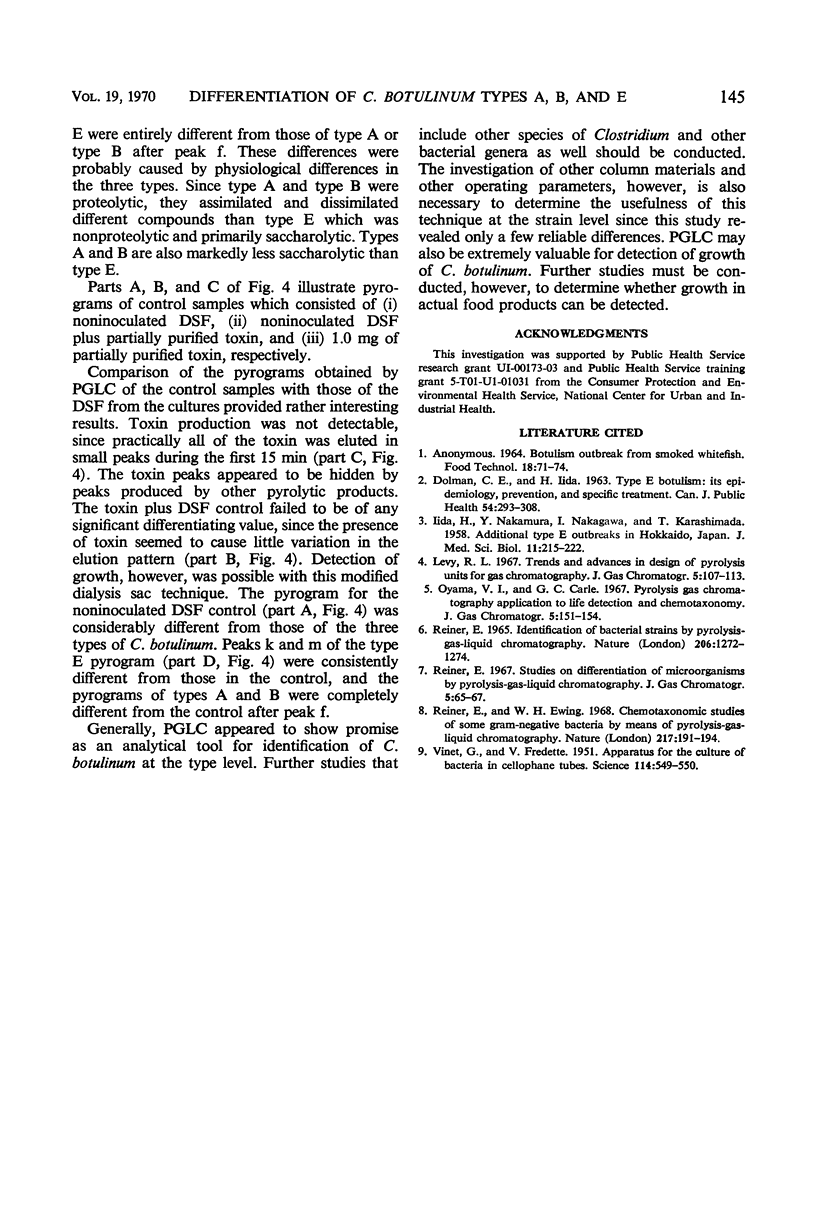Abstract
Vegetative cells and spores of 10 strains of Clostridium botulinum representing types A, B, and E were grown in Trypticase-peptone-sucrose-yeast extract (TPSY) medium. Five type E strains were also grown in Multipeptone-sucrose-Nutramino acids (MSN) medium. Lyophilized samples were subjected to pyrolysis-gas-liquid chromatography (PGLC) analysis, and the resulting pyrograms were examined for variations in elution patterns between spores and vegetative cells of types A, B, and E grown in the TPSY medium and spores and vegetative cells of type E grown in the TPSY medium and spores and vegetative cells of type E grown in TPSY and MSN media. Growth and toxin production of all 10 strains of C. botulinum were investigated by using a modified dialysis sac culture technique. The dialysate supernatant fluid (DSF) obtained after centrifugation of the 5-day-old cultures from the dialysate was also subjected to PGLC analysis. Control samples consisting of (i) noninoculated DSF, (ii) noninoculated DSF plus partially purified toxin, and (iii) 1.0 mg of partially purified toxin were also analyzed by PGLC. Differences between pyrograms of cultures were suitable for positive identification at the type level but not at the strain level. Pyrograms permitting differentiation were also obtained between spores and vegetative cells as well as between the same cultures grown in different media. The dialysis sac technique was useful in detecting growth but not toxin production of C. botulinum.
Full text
PDF







Selected References
These references are in PubMed. This may not be the complete list of references from this article.
- DOLMAN C. E., IIDA H. Type E botulism: its epidemiology, prevention and specific treatment. Can J Public Health. 1963 Jul;54:293–308. [PubMed] [Google Scholar]
- IIDA H., NAKAMURA Y., NAKAGAWA I., KARASHIMADA T. Additional type E botulism outbreaks in Hokkaido, Japan. Jpn J Med Sci Biol. 1958 Aug;11(4):215–222. doi: 10.7883/yoken1952.11.215. [DOI] [PubMed] [Google Scholar]
- Reiner E. Identification of bacterial strains by pyrolysis-gas-liquid chromatography. Nature. 1965 Jun 19;206(990):1272–1273. doi: 10.1038/2061272b0. [DOI] [PubMed] [Google Scholar]
- VINET G., FREDETTE V. Apparatus for the culture of bacteria in cellophane tubes. Science. 1951 Nov 23;114(2969):549–550. doi: 10.1126/science.114.2969.549. [DOI] [PubMed] [Google Scholar]


